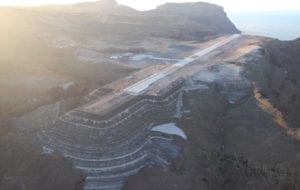History was made recently as the first ever aircraft touched down on St Helena Island in the South Atlantic Ocean representing a momentous milestone in the St Helena Airport project which was officially announced by the St Helena Government in November 2011.
Nearly four years later, the construction of the St Helena International Airport is nearing completion and the first regular flights between O.R. Tambo and St Helena are expected to commence in late February 2016. The airport project is destined to change the lives of all St Helenians, known as Saints, not only in providing employment with opportunities of new skills, but it will also boost the island’s economic growth with increased tourism and stimulate the expansion of support industries. Following the announcement of the project at the end of 2011, Basil Read was awarded the design, build and operate contract by the St Helena Government and WorleyParsons was appointed as their lead design engineering consultant.Overcoming extreme challenges
The island’s remote location, as well as its unique ecology, required advanced engineering ingenuity and planning. Virtually everything, excluding rock and water, had to be shipped to the island as there was no major construction plant or building materials on the island. The project design features required careful consideration of ease of constructability and programming of design delivery, requiring close integration of the design and construction team members.One of the biggest challenges addressed by WorleyParsons was the rock fill of a 120 m deep by 750 m wide dry gut gorge required to construct the 2 000 metre long concrete surfaced runway.
The dry gut fill consisted of 8 million cubic metres of blasted rock, or the equivalent of 450 000 truckloads of material. 19 trucks were used day and night, with 503 day shifts and 437 night shifts taking place over 22 months to completely fill the dry gut. “We are very proud to have been involved in this prestigious project and would like to thank the entire team for contributing to this tremendous feat,” says Du Bruyn Jonker, project manager at WorleyParsons. The airport will be operated over the next 10 years by Basil Read. The completed runway can handle a B737-800, A320 and B757-200 (with weight restrictions) and the A319. Weekly flights from Lanseria will be operated by Comair, to be announced following official airport certification, with proposed monthly flights to and from St Helena and Ascension.Scope of works
- A 14.5 km access road from Rupert’s Bay, where the capital city of Jamestown is located, to the airport site,
- a 680m long concrete culvert and attenuation dam,
- the dry gut fill,
- a 1 950 m long concrete runway plus aprons and taxiways,
- bulk fuel installation for 6 million litres of fuels,
- an airport fuel facility,
- a 2 500 m² terminal building,
- a combined building to serve as the ATC tower and fire department,
- infrastructure services,
- aerodrome ground lighting and navigational aids,
- Airport operations equipment and airport certification








